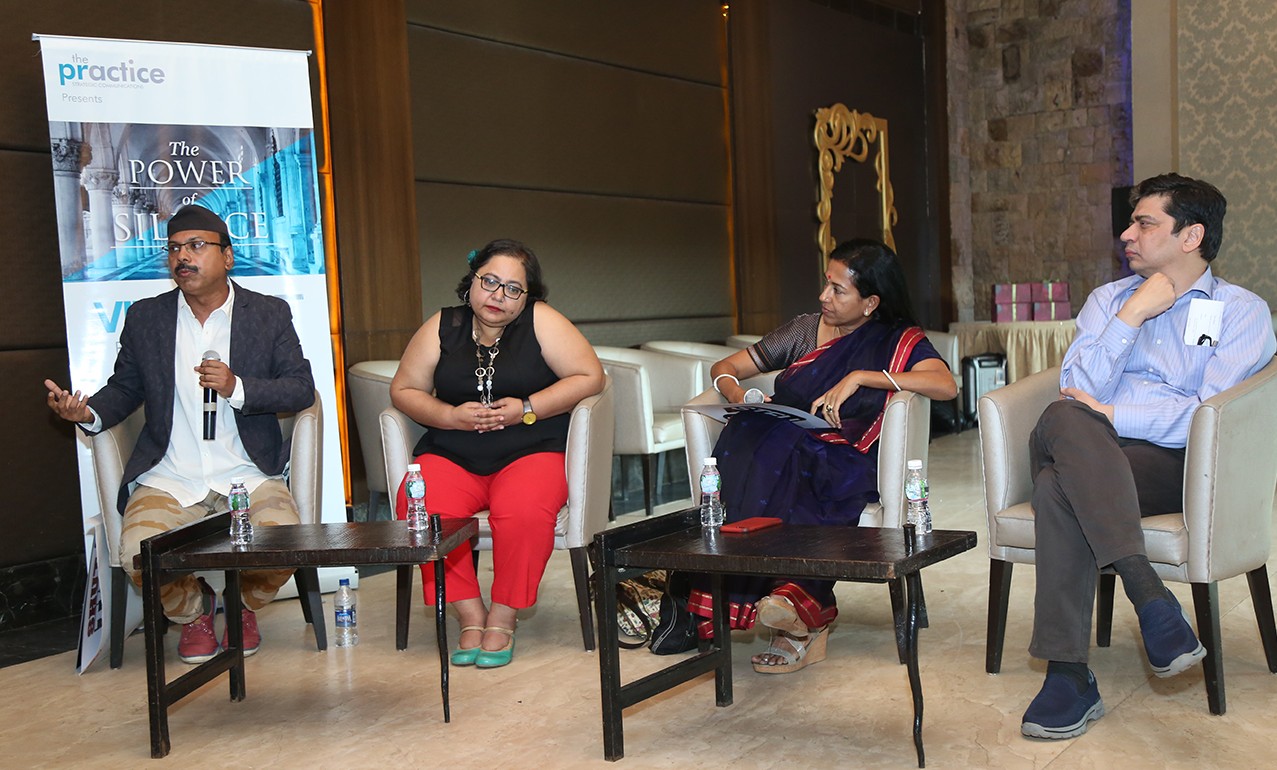Edited excerpts from the 3rd Viewpoint Roundtable
September 24, 2015 at Gallops, Mahalaxmi, Mumbai
Moderators
Shoba Narayan
Author and columnist
Participants
Josy Paul
Chairman and Chief Creative Officer, BBDO
Paromita Vohra
Filmmaker and writer
Santosh Desai
MD and CEO,
Future Brands India Ltd.
It was hard to predict what a conversation on silence would yield. Words and silence, after all, are on opposite ends of the communication spectrum. Could one convey the depths and facets of the other?
We found it could. Our panel of creative thinkers began by mapping silence to our lives – as a choice, a legal right, a manufactured commodity, a path to self-
awareness – before delving into how it is viewed, interpreted and leveraged. It was both profound and light in parts. Nobody felt compelled to talk when it was over.
PHILOSPHICAL VIEWS ON SILENCE
Shoba: Firstly, there is silence and sequence. When do you stay silent and when do you speak – in a corporate or public environment? Then there is silence as a strategy. Modi appears to have mastered this, regardless of whether you agree with it or not. The Queen of England, currently the world’s longest reigning monarch, has managed to stay silent through much of this reign. You can’t misquote silence in this media heavy world. Conversely, Angela Merkel who is known to be reticent has spoken up for the Syrian refugees. She used her previous silence and strategically broke it to emerge as the moral vanguard of Europe.
We often associate silence with self-awareness and with listening. Then there is silence as a path to spirituality. Every great religion teaches us this, whether through Vipassana, meditation, or Maun Vrat. You stay silent in the hope of reaching inward and reaching a higher level.
Lastly, silence is codified in the legal world. When the Miranda rights are read out, the first that is mentioned is the legal right to remain silent.
Santosh: You could imagine silence as a successive stripping away of different layers. You strip away the political. Then you are left with the cultural. Picture yourself sitting in an office worrying about politics to begin with and you create silence by stripping away that noise. You still have the noise of culture around you. You strip away that noise and you have the hum of the air conditioner that you don’t realize is there till you switch it off. To switch off the noise of the city, you go to the hills and you hear the crickets there. You strip away the noise of nature and you hear the sound of your heartbeat.
So, what do you escape from and what do you escape to? The various layers – whether they are techno-
logical, cultural, or natural are overall layers of life. In an earlier world perhaps, the abiding condition was silence and sound was the product of life. Today, it’s almost as if the abiding condition is sound and therefore, silence becomes something that we can try; something that we retreat into; something we manufacture.
Paromita: Silence has now become a concrete activity that also has to continuously produce a very quantifiable and knowable result. This is actually antithetical to the idea of silence because I believe silence is part of sound. It’s not the same as noise but it is a sound that is also around us. It is a place between sounds. Every time we speak or we say a word, we name something, but the very fact that we have made one thing tangible or known through a word requires that we silence another meaning of that same thing. Silence then holds all those other meanings. So, when people tell us there is concrete spirituality or a concrete kind of behavior linked to spirituality and silence, it is still a sort of noise.
Josy: The problem I have with silence is that it’s boring. It’s old-fashioned. It makes you think of some men sitting cross-legged on top of a mountain. Silence comes to mind when my librarian says ‘ssshh’ or when we observe a minute of it to commemorate someone or something. It says something about death and loss. Clearly, silence is not all that. So, there is a problem with the word.
I am in advertising and we have a need to rebrand stuff in this industry. So, I am trying to rebrand silence to make it more enjoyable, exciting, and desirable; so that people want it and then they start looking at the deeper meaning of silence. You start by talking about benefits that the larger world wants from silence. You point out immediate rewards and then as they get engaged, you start revealing the layers.
Silence does not have to be an induced artificial thing in our lives. It can be a part of your daily shave or bath. Somewhere, in these activities you can find silence and it’s beautiful because it’s everyday and part of a ritual.
Here’s a word I would like to share with all of you (holding up a board). Some of you may know this already: STFU. Shut the F*** Up. It’s a different way of referring to silence. There is a little more energy in this and it brings more people in because now they say: I like that because it’s real. It doesn’t belong to my parents or grandparents or people who live in the mountains.
MAKING ROOM FOR SILENCE
Josy: I find the night is a beautiful space for silence. It’s at the crossroads of so many things and you know that dawn or light is going to hit you soon. In the office, there was a time when we tried a quiet hour every day from 9 to 10 am when you don’t impose on each other. You spend time catching up with yourself. But with daily work demands, that practice soon died. So you go back to finding your own way. There is no organized ritual. People want the benefits of silence without necessarily using the word. For example, if someone had a breakup, everything hurts, right? They don’t want people around them. They want that capsule of silence so that they can feel it. It’s an unsaid, unwritten understanding…a sort of retreat.
Santosh: In our work, most of us are trying to make sense of things that we see around us, particularly at an aggregate level. We are trying to understand what is happening in the world, why it is happening, what are the kinds of movements that are taking place.
How do you discern something from such a large, fragmented and contradictory mass? The classical way is to talk to people and then to extrapolate that to a larger universe. But I have found that it’s not what people say that is most interesting. Observations and seeing things can be equally, if not more interesting. We often are blind to everything that is obvious around us because we know it before we see it. Therefore, we don’t see it.
So, the sort of observation that is rooted in silence is a useful way of being able to pick up, decode, and connect in order to arrive at a slightly larger understanding. The ability to see a pattern has a lot to do with silence. I think it has a lot to do with asking why so many girls in small town India who traditionally wore their hair in braids and pigtails now have bobbed hair. It’s a small piece of observation at one level but it could lead to a better understanding of something bigger. I find that there is distraction in our dependence on what people say rather than what they mean or how they behave or where they live. Our desperate need to hear comforting sounds emanate from the other side that we can then capture and synthesize makesit difficult for us to actually experience what we are experiencing.
Paromita: I don’t make beautiful, arty, and quiet movies and there is hardly 30 seconds of silence in a 90-minute
film of mine. But I think I have learnt a lot about the idea of silence from film making, specifically about listening without the fear of not getting to say my piece. In a sense, art and its practice give you that possibility. There is a lot of anxiety in young people today. They want to excel, to get ahead, to do well. But the practice of arts allows you to let go of your anxiety. It allows you to let the world in by listening to somebody. And that actually completely transforms you. Every time that I have done it and I have spoken to somebody whose views I don’t agree with, I have come away changed in the way I look at them, at myself and at an entire set of ideas that are involved there.
SILENCE AND CREATIVITY
Shoba: Neuroscience has shown a clear link between silence and creativity. Apparently both Thomas Alva Edison and Salvador Dali used to lie in bed holding metal balls in their hands. They would lie silently, holding them up and not allowing them to fall. The minute they fell asleep, their hands would drop, the metal balls would make a sound and they would wake up. And in that twilight zone between sub consciousness and consciousness, is the wellspring of creativity. The Pomodoro technique involves a variation of this. It encourages people to work in twenty-minute segments separated by five minutes of breaks or walks in the garden. This may also be why many of us get our best ideas in the shower. It sets a vacuum in motion to take our ideas from the backs of our minds and push them to the front.
Paromita: You need time to consolidate yourself and all the things that you have experienced. You need to make your being ready to produce and stream that which has been fragmented inside you. As an artist, you can have an extreme approach to socializing that others may find hard to understand. I personally can go from extreme gregariousness to not answering calls for a length of time.
I do need to disconnect from the world during this process. I have a ritual of teaching myself a Hindi film song in the morning. I just listen to it till it’s completely in my head and allows me to sync with one mood or one feeling. But I think it’s no different from getting ideas in the shower. It’s a process of using sound to shut out other sounds.
POWER AND POLITICS
Paromita: I think that women, particularly, struggle with how to define themselves in presentation and are constantly wondering: am I talkative, am I too loud? It is a crisis of sorts and the solution lies in changing how both men and women think of themselves and of the other gender. Following the December 2012 gang rape in Delhi, issues of women, feminism and violence are widely discussed. It’s a necessary conversation but it may be drowning out a space to define these things in a fresh way. I personally think that the only way out, aside from a big feminist revolution (which won’t happen) is to allow for more art and artistic products to define that space and that multiplicity of what it means to be a woman.
Shoba: When it comes to speaking up, there is some good news for women in the boardroom. According to a
New Yorker article, speaking up 30% of the time was viewed as the right amount for female executives. If they spoke more than that, it was construed as pushy and aggressive. However, the silver lining lies in the finding that a younger generation of boys raised by working mothers did not have that preconception.
Josy: In the workplace, I believe silence is a gaming tool because it creates a low pressure zone that begs to be filled.
When you stay silent, the discomfort affects the other person and you start receiving information. So you use discomfort as a gaming tool to receive. You could call it listening or manipulation, depending on how you are listening. The power
lies with the person who can hold on. In a group, it depends on what’s happening in that room and the dynamics of the group. If there is deathly silence after you have just finished an important client presentation, it can be very frightening because something has to give. This happens so often in our industry that, at one point, we decided we couldn’t handle it anymore. So we had one person in the group bring out a guitar and start strumming and singing just to kill the tension.
Coming back to internal dynamics, there is often – as Santosh already said – a hierarchy of silence in the room. Usually the person who is the most nervous is the loudest and tries to engage the others more. In the end, everyone is intuitive in the silence game. It’s an interesting game of silence and sound that reveals where the confidence lies in the room. It’s not authority; it’s confidence.
CONFIDENCE AND MORE
Josy: When you are a trainee and you are in front of this massive group of people who are all watching you, the
only thing that gets you through is your belief in your idea. It’s not about silence but about belief. You are not thinking about anything other than the idea that you have.
Santosh: At a personal level, I find myself being articulate in the public forum but utterly inarticulate when it comes to social interactions. So silence is an abiding condition with me even though, once I have a microphone in my hand, I can transform into this loquacious sort of being. To that extent, I have struggled with this question of silence and the lack of it all throughout. In many situations, it becomes uncomfortable for the other person because you impose your silence on the other person and place that responsibility on them to speak.
Paromita: I want to share a great story about the actress Rekha who once came to this book launch I attended. I am a big fan like everybody else in the country. We were all waiting for her and she arrived at the event, an hour and a half late. She came, wearing her trademark gold silk saree, her pallu touching the floor. We were full of anticipation in the audience and couldn’t wait to hear her speak. When she did speak, she said: “You know, silence is more powerful than words. And so, I will just stay silent. Thank you for inviting me.” I couldn’t believe that was it. But in a way, she left you trying to decipher her meaning and intent. Was she nervous? Or just trying to preserve some sense of mystery? We would never know. It was like a small Monalisa moment and a performance, in its own right.





